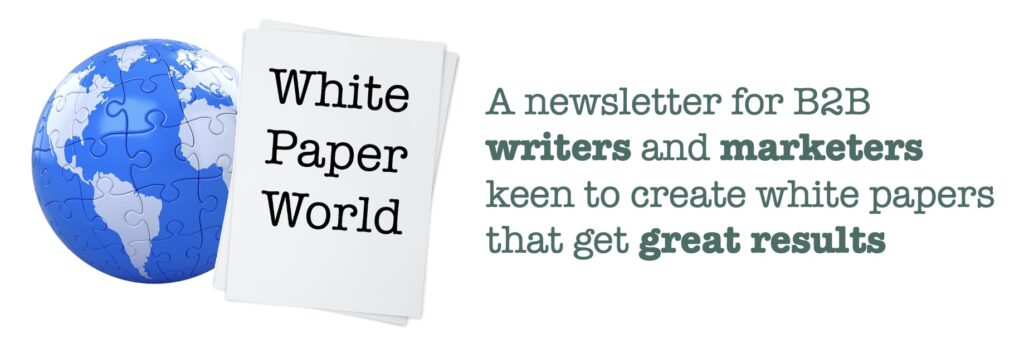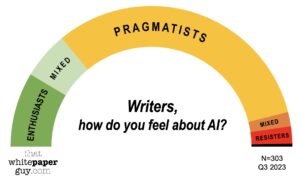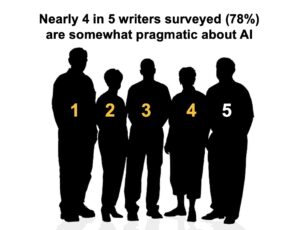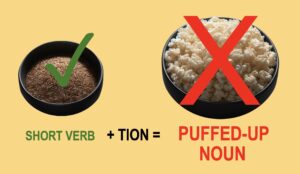
White Paper World 31: October 26, 2023
- This just in: Results of my AI survey for writers
- Tools of the trade: How I used AI for this report
- Quick tip: 5 tricks to avoid spooking prospects
This just in: Results of my AI survey for writers
I recently took a survey of writers, with the goal to see how people in my circles were feeling about AI.
The questions were intended to sort respondents into three groups:
- AI Enthusiasts, who often use AI on the job
- AI Pragmatists, who sometimes use AI
- AI Resisters, who seldom or never use AI
Just over 300 writers completed the survey. Here’s a quick look at the results.

For those who prefer seeing data in a table, here it is:
| Category | Number | Percent |
|---|---|---|
| AI Enthusiast | 52 | 17% |
| AI Enthusiast + Pragmatist mix | 33 | 11% |
| AI Pragmatist | 194 | 64% |
| AI Pragmatist + Resister mix | 10 | 3% |
| AI Resister | 12 | 4% |
| Other | 2 | 1% |
| TOTAL | 303 | 100% |
AI Pragmatists were by far the largest segment at 64%. These are people like myself who use AI if we see a likely benefit but recognize some problems with the technology.
AI Enthusiasts trailed by a long margin at 17%. These are people who use AI every day on the job, and believe it offers far more benefits than drawbacks.
AI Resisters were just a tiny sliver, only 4%. These people don’t use AI today and never want to in the future.
The remainder were too close to call, so I called them “mixed”:
- AI Enthusiast + Pragmatist = 11%
- AI Pragmatist + Resister = 3%
Nearly 4 out of 5 writers surveyed are pragmatic
Two out of three respondents (64%) were clear AI Pragmatists. But if we include both mixes, almost four out of five (78%) writers surveyed are somewhat pragmatic about AI.
Pragmatists have tried AI. We can see its benefits for certain tasks. But we still have concerns about the future.
This means a vast majority of respondents see AI as a tool to be used judiciously. We’re neither over-the-top Enthusiasts nor dig-in-our-heels Resisters.
This suggests that many writers in my circles already have a balanced understanding of AI’s potential and its limitations.
Exposure to AI boosts pragmatism
Three questions delved into each respondent’s exposure to AI:
- Q3: Have you ever tried using AI to help you write?
- Q4: How much do you know about AI, compared to your peers?
- Q7: How often do you try out a new AI tool?
The data suggests that the more a writer was exposed to AI, the more likely they took a pragmatic attitude.
Perhaps by using and learning more about AI, people tend to realize more about the practical challenges and benefits associated with it.
How do you feel about content generated by AI?
Question 5 asked, “How do you feel about AI-generated content like articles, books, or marketing materials?”
This is where the rubber meets the road for writers, after all.
Not surprisingly, the answers fit the respondent’s categories.
AI Enthusiasts were generally positive about AI-generated content. Pragmatists were mostly mixed, and AI Resisters were mostly negative.

How good is AI writing, anyway?
Question 8 asked respondents to rate the writing they’ve seen from AI on this scale:
- B-grade copy: Better than the work I’ve seen from most human writers
- C-grade copy: Worse than the work I’ve seen from most human writers
- D-grade copy: Terrible, flat, uninspired, soul-less
Again, the answers lined up neatly with the respondent’s category.
In fact, 96% of Enthusiasts gave AI writing a B, every single Pragmatist gave it a C, and every Resister gave it a D.

Can AI be truly creative?
Two questions probed whether respondents believe AI can truly be creative:
- Q6: How do you feel about using AI in your creative work?
- Q11: How much do you believe AI can enhance human creativity?
Again, AI Enthusiasts look for ways to use AI often, even in their creative work. Pragmatists use AI when it promises to be useful. Resisters don’t.
The answers to Q11 showed a lot of skepticism about AI’s ability to be genuinely creative, across the board.
Perhaps this proves how much writers, of all people, value human intuition and creativity.

Writers worry about our careers
Two more questions explored the likely effects of AI on our writing careers:
- Q9: How much do you think AI will affect your career in the next 12 months?
- Q10: Are you worried about how AI may affect the future of your career?
The majority of respondents are concerned about AI’s impact on our writing careers. And no wonder!
—We’ve heard how the training databases for AI are jammed full of our books, used without our permission.
—We’ve seen Hollywood writers on strike for months over this issue.
—We’ve watched AI do hours of work in mere seconds.
At this point, only the most AI-enthusiastic think they’ll do more and earn more using AI in the next year.
Many more writers are concerned that writing fees will go down and the perceived value of writing will be diminished.
AI’s impact on society
Question 12 rounded out the survey by asking about the long-term effect of AI on society at large.
These answers were all over the map. Even Enthusiasts have some doubts here. And surprisingly, some Resisters think AI might not be all bad.
It’s probably too early to know. After all, ChatGPT-3.5 was unleashed on an unsuspecting world less than a year ago.
Many answers reveal mixed feelings
Speaking of mixed feelings, about 15% of the respondents fell on the border of two categories, into a so-called “mix.”
I defined these as anyone whose scores fell within 10 points of another category. That meant answering just a single question differently would land them in the other category.
While categories can be useful, they’re certainly not absolute.
In fact, several respondents complained they felt shoe-horned into a simplistic answer that didn’t capture their opinion.
Or they wanted to reply, “I don’t know.”
The range of answers showed that many writers hold mixed feeling about AI. And that’s probably a realistic way to look at it.

AI Resisters are a small but important minority
While a tiny minority in this sample, AI Resisters represent an important voice.
They remain skeptical about using any AI in their creative work. And they believe AI could replace human creativity with an inferior facsimile.
These concerns are not wrong-headed nor silly.
Resisters can provide critical insights into the potential pitfalls of AI that Enthusiasts and Pragmatists might overlook.
Who knows? Maybe a few years from now, everyone will wish we’d resisted AI more!
This was not a scientific survey
- Respondents were self-selected from my newsletter subscribers and anyone who saw my social media messages
- There were incentives: feedback on managing your career in the age of AI and the chance to win a book on writing
- The survey collected no demographics on the age, sex, education, or location of the respondents, or even what kind of writing they do
And as for the numbers, 303 is a fraction of the subscribers who open every issue of this newsletter.
So this survey drew in a small number of writers, perhaps those most keen to register their views or get one of the incentives.
For all those reasons, this was not a scientific survey.
Conclusions
Still, this gave an interesting snapshot of the people in my circles.
The results show a community of writers who are somewhat optimistic about the potential of AI. But we have reservations.
Thank you to everyone who took the survey.
I’ll be carrying on with my coverage of using AI to help write long-form content, especially white papers.
P.S. If you didn’t do the survey yet, I’ll leave it up so you can see which bucket you fit into. The link is here: https://app.agolix.com/assessment/20536
Tools of the trade: How I used AI for this report
 In analyzing the survey results, ChatGPT-4 probably saved me two days.
In analyzing the survey results, ChatGPT-4 probably saved me two days.
I already had an Excel file of the results, but that far exceeded the AI’s prompt size limit.
So I had to rethink the process and use workarounds like multiple uploads of small segments of data.
Once I had all the data in ChatGPT, I sat with it for an afternoon analyzing the results. The AI certainly helped to spot trends and correlations.
Sometimes it suggested a formula to test a hypothesis. Then I’d go back into Excel to check the formula.
When I asked for some overall observations, ChatGPT wrote a rough draft of the article you see above.
But I completely rewrote it using shorter words, more concrete details, and a more conversational tone. And then I revised it several more times.
So once again, the AI helped in the early stages, but not to create the final results, which took human editing.
Quick tip: 5 tricks to avoid spooking prospects
This Halloween, while ghouls and goblins rule the streets, make sure that your white papers don’t join their spooky ranks.
Here are five tips to make sure your white papers are welcome treats that your prospects appreciate.
Trick 1: Exorcise the ghost of irrelevance
Nothing is more haunting than stale or irrelevant content. Like a ghost, outdated information lingers in the air, distracting from today’s pressing problems.
Do diligent research. Make sure that every piece of data, every reference, and every assertion is timely and relevant.
Use the proof points you dug up to banish outdated opinions that still haunt your prospects.
Focus on the reality of today and the promise of tomorrow, not the ghosts of yesterday.

Trick 2: Clean up the poltergeist’s disarray
A poltergeist can cause havoc: moving things around, banging and moaning at night, and turning a peaceful house into chaos.
Much like these disruptive spirits, a white paper that lacks a structured flow of ideas can disorient and displease readers.
Avoid jumping between points or including “noisy” clutter that detracts from your narrative. Every element you include should advance your argument.
Keep your white paper neat, tidy, and free from distracting disturbances.
Trick 3: Avoid the zombie jargon apocalypse
Jargon-laden text can turn your white paper into a lumbering zombie.
No writer can avoid using some industry-specific terms. And showcasing your company’s expertise can be valuable.
But splattering buzzwords throughout your paper is overkill.
Jargon-riddled sentences often shuffle along slowly and say nothing, rather like zombies.
Don’t suffocate your prospects with a pile of undead jargon. Keep it out of your papers!
Trick 4: Don’t hide behind the mask of ambiguity
Masked villains abound in horror movies. And the masked fiend of white papers is unclear expression.
If your readers spend more time deciphering your text than absorbing your message, their interest will wane.
Unmask your intentions, so that your white paper’s meaning shines through. Don’t let your key points remain shrouded in mystery.
Provide clear and unambiguous statements. Don’t leave your readers wandering through the fog.
Trick 5: Escape the werewolf bite of unreadability
Legend has it that on a full moon, a few unlucky people change suddenly into werewolves.
That’s rather like plunging from the bright of day into the dense, dark woods where you can’t even tell where you are.
As the writer, here are some silver bullets you can use to help avoid the werewolf’s bite:
- Structure your content thoughtfully
- Use subheadings, bullets, and tables to break up the text into clear and easy-to-manage chunks
- As you revise, add more of these “text organizers”
- Type notes for your designer right in your draft
- Most of all, ask your designer to use 100% black text and leave lots of white space
All these will bring your white paper out of the shadows and into the light.
This Halloween season, remember that your white papers should be scarily precise in their explanations and spellbinding in their clarity.
Follow these tips to help your white papers enchant your prospects.
That’s all for this issue
You can see all the previous issues of White Paper World here:
www.thatwhitepaperguy.com/newsletters/
And to see every future issue, make sure to subscribe here:
www.thatwhitepaperguy.com/subscribe/

Gordon Graham
That White Paper Guy










